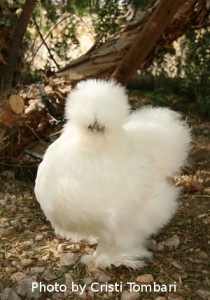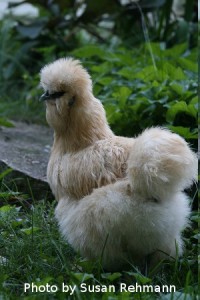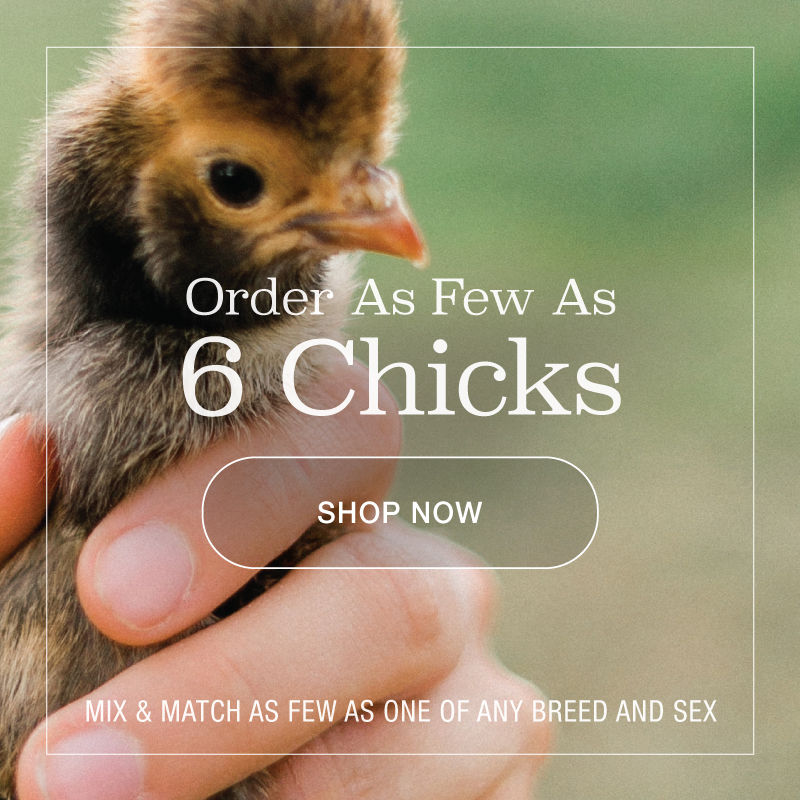 History
History
Silkies are a unique breed of chicken, thought to have originated in China or Southeast Asia.
The first recorded history of Silkies occurs in Marco Polo’s writings about his travels to Asia in the 13th century, in which he describes chickens with fur-like plumage black skin.
Silkies were admitted into the Standard of Perfection in 1874.
Qualities of the Silkie
There are a lot of things to like about the Silkie.
- Broodiness – One of the main characteristics that Silkies are known for is broodiness. Silkie hens have a strong tendency to go broody, and they make excellent mothers.
- Temperament – Silkies have a wonderful temperament. They are calm, gentle, and docile. They are easy to raise and get along well with children. They quickly get used to being handled by people.
- Excellent Pets – Silkies make excellent pets. Their unique appearance and behavior adds to the enjoyment of watching them.
- Tolerate confinement well – Silkies tolerate confinement well. Because of the nature of their feathers, they tend to not fly out of fences easily, so it is easier to keep them contained than some of the flightier breeds.
 Physical Appearance
Physical Appearance
- Feathers – The silky appearance of the Silkies’ feathers are what give it its name. Their feathers lack barbicels, the hook-like barbs that exists in the feathers of other chicken breeds and which hold the parts of the feathers together, giving them there usual appearance. This lack of barbicels is what gives Silkies their “silky” appearance.
- Skin color – Silkies have dark blue skin which looks nearly black. The meat and bones of Silkies are also dark blue. This is true regardless of their feather color.
- Five toes – Most breeds of chickens have four toes on each foot. The Silkie has five.
- Plumage color – Silkies are available in a number of colors. Those which McMurray Hatchery carries include Blue, Buff, White, and Black
- Blue Earlobes – Silkies have blue earlobes.
- Feathers on legs – As can be seen in the photo above, Silkies have feathered legs.
- Crest – Silkies have a crest of feathers on the top of their heads.
Egg Laying
Silkies lay small to medium eggs that are cream colored to light brown. Silkies are not prolific layers. When Silkies are not broody, they will lay dependably, but not as consistently as production breeds. When they are broody, they will stop laying.
Rain
Because the Silkies’ feathers lack barbicels, they don’t shed water as well as many other breeds. Water tends to soak them rather than bead up and roll off, so they need ample protection against rain.
Videos of Baby Silkie Chicks
httpv://www.youtube.com/watch?v=KRy0wqKhXN4
httpv://www.youtube.com/watch?v=m0PYzUfHnmU
httpv://www.youtube.com/watch?v=aMhOCAiiE94
Availability
To check the availability of Silkies on our website, visit the links below:
Feedback
We’d like to hear from you. If you’ve raised Silkies, please leave us a reply letting us know what your experience with them has been.



We had given away all our chickens to move across country. When our move was postponed, two friends each gave us a motley crew of misfits from their respective flocks. Red Stars, Leghorns, a Barnvelder, a Silver Laced Brahma, and a white Silkie rooster and a blue Silkie hen that we had raised from chicks. Amazingly, there is very little squabbling among them. We had an extremely cold winter and the Silkie hen learned to roost with the larger breeds, cuddling up to them for warmth. It’s fun to watch her follow the huge Barnvelder and the Brahma around the yard. They are very docile and she clearly prefers them. She went broody for much of the winter, sitting on anyone’s eggs she could. Unfortunately, I had already given her tiny eggs away. They were probably fertile and she could have been a mother. The rooster was another story. He was only mildly aggressive at first and his attempts to attack me were funny because he would just bounce off my rubber boots. Gradually, he became more and more aggressive and was able to jump/fly to about my chest level. I wasn’t comfortable turning my back on him and couldn’t risk him possibly hurting my young grandchildren. Although I like having a rooster in my flock, he is no longer of this earth.
Your white Silkie rooster must have been an ADHD or something. I have had all of the colors, hens and roosters, and none of them have ever acted that way. I currently have 2 silkie hens on new chicks, and the big Blue S. rooster is a proud papa. He had always just come to me and follow me all around like a puppy, all the while singing. I can pick him up, hold him, and he sings while I hold him. Others can hold him too. I would say, don’t give up on them. You just need to be selective about breeding that trait in or out.
I have one mature male silkie Blackie who is the guardian of my six other silkies. He was a sweetest fellow ever until I introduced the little guys into the coop. He hovers over them all day and is no possessive it is difficult for me to change their water and food. If I can manage to capture him without being pecked, I will catch him in a bath towel, hold him close and tell him what a good little beast he is, and he’ll be my friend again, until I put him back with the babies. I am hoping as the babies mature, he’ll get over it. I have not been able to sex them, but I only can keep the hens (I already have one other roo– a Penedesenca).
I have silkies and truly enjoy them. right now I have numerous hen brooding and numerous babies right now. The babies are so tiny!!!
Colene
I love Silkies and have had several batches so far. I am getting 25 more chicks and already have 6 that I got from Tractor Supply and 2 that I hatched. I am focusing on breeding Silkies and showing them, so I have to get some more considering I only have 3 show quality pullets. I really need a show quality rooster because I had to sell mine because he wasn’t show quality. I LOVE SILKIES. They are my favorite breed and are just so cute. IF YOU WANT A GREAT CHICKEN GET SILKIES!!!!!
i’m near tampa, fl can you tell me where i might find one or better yet will you sell
I received two white Silkie pullets — barely changed from chicks to pullet ladies — as a Christmas present from my daughter and son-in-law who spoiled them very well! Such sweet little birdies! Now, my Silkie numbers are 4 with two white, one buff, one black. They all get along pretty much and are so comical to watch when running to the patio for their afternoon greens or dozing and fluffing dirt on them in our raised garden bed! The newer birds give us an egg nearly every day, but they are gifts from pet birds. They are very loving birds and don’t mind me picking them up to love and talk to. They don’t take any bullying from our large dog and will flap their wings and chase him away! You go girls! Of course, I want more. Regulations here in suburbia restrict my hen numbers, so we are waiting for retirement acreage to have flocks of the beautiful animals. I would highly recommend these beautiful, hardy birds for novice owners. Kids seem excited to get an egg from such an unusual animal!
I too have had a great experience with Silkies. I am part of a group of ladies that provide a farm day for our little towns elementary school. The Silkies are a huge hit because they like to be held, and even children that say they are scared of chickens seem to take a shine to them. I can’t wait ’till it warms up enough to order my next generation of them. McMurray has the best selection by far that I’ve seen. Thank you!
I have worked with and had Silkies before in zoos and known of private duck breeders, who use them and Silkie/Cochin crosses for brooding duck eggs, as they are such excellent brooders.
We finally have built our own coop, and I am anxiously awaiting my first order of Silkies for myself. I love these guys, and Frizzles also. Even have AC set up for them in the hot NC summers. Just two more months…..I have a five year old daughter, and soon will be able to share the love of chickens with her!
A friend gave me a Polish Crescent & from her I decided I wanted some chickens. I purchase the last 4 at a feed store. They did not know if they were hens or roosters. Well 2 turned out to be Silkie roosters. One is solid white with a ruffle cone and the other is smaller but blue with a regular cone except there are 3 of them. They are wonderful, but I am trying to sell them because they each need their own hens. The other 2 turn out to be, I think, Millie Fleur, too small for the Silkies. The rooster love for me to pick them up and love on them. They are so funny. They are very hardy. Our temps have been single digits, and I just have tarps over the pen. They do very well. The 2 hens sleep underneath them! Ha ha. They do crow very loud. When they want a treat, they come to the edge of the pen and crow for me!
We had a silkie that we bathed and colored pink with koolaid. Her name was Pinkie. She was in with a bunch of other hens and did fine but she had rights that the other hens did not. Pinkie got to go out of the pen and roam around when ever we were there, so if we were in the garden or just down at the “chicken ranch” she would get to be out and just peck and scratch to her heart’s content. I hosted a garden walk one time, and everyone was so amazed at our pink chicken. She never strayed far and loved to sit on my daughter’s shoulder. We have had more silkies since then, and I would recommend them to anyone who wants a very nice pet chicken.
I had gone to work for a potter. She was always trying to give me a chicken she had in her backyard. She did not know where the chicken came from. One afternoon when I was getting ready to leave, she brought a large packing box to me and told me to take it home. I looked into the box and was shocked! I was raised on a farm and was acquainted with Leghorns, but this critter was something that I had never seen before. “Are you sure this is a chicken?” I asked.
So I took it home and waited for my husband to come home. When he opened the box and tumped it over, out rolled a little white puffball plus a blue egg? She looked up at us with a “buck buck” to tell us she was finally home. She was so sweet following us around the yard like a dog and scratching out all the piles of leaves that we raked up. In her honor, my husband built her a hen house and bought some friends for her. We will never forget Chiquita Bonita who taught us how sweet and gentle chickens can be.
I just got my first Silkies a few weeks ago. 4 Blue Silkies. They are by far the sweetest little things. So calm and very quiet. I haven’t mingled them in with the rest of the chickens because of how calm they are. I’m scared for them with my big birds. I’m still learning about them, but I have already completely feel in love with them.
I too have silkies. They have there own little house because they don’t do well in with the big girls because they are so laid back.I love them; they are so fun to watch, and they will take any egg and hatch it out and make great mothers. My rooster is the best dad; he knows when the chicks hatch, and he talks to the little ones as well as the mom, and when she brings the little ones out, he is so proud of them, and he starts rights away protecting them and showing them how to dig and eat. I just can’t say enough about this breed. They can stand a lot of cold. By looking at them you would think that they are a wimpy breed but no to that. I do have a heat lamp for them in the winter when it gets really cold; their coop has been down to 18° before, and they have been fine, but I do have 13 together, and they huddle together to keep warm. It is said that they don’t roost, but I do have a couple that like to roost. I have them for their cuteness, and I need broodies to hatch eggs, as I don’t have or want an incubator. They are VERY broody; I have one right now that is broody, and it’s the middle of winter; I keep taking her eggs, and she keeps laying and setting. I don’ worry about her too much; she is eating and drinking, and I keep taking her off the nest. I could go on and on about them, but I’ll stop now. LOL
Many many years ago, we purchased on a whim 3 live White Silkies from a Chinese meat market on Grant Street in San Francisco. We took them to our place in the forests of Mendocino County where they quickly interbred with our Bantams and thrived quite well there for years, creating the most remarkable strangely feathered birds. They were hardy and survived a semi-feral existence.
You are right! Silkies are amazing little breeders. A friend of mine found 12 quail eggs after seeing the mother killed. She rushed the eggs to me and we put one of my wonderful brown silkies on top of the eggs which she sat on immediately. After almost a month, I thought it was not to be, when all of a sudden, 11 of the 12 eggs actually hatched. They were like little pieces of popcorn rushing around the cage. I eventually took the babies to a wildlife center where they were going to raise and release them to the wild at the proper time. Silkies rule!
The only silkie I had developed a neurological? problem…and couldn’t stand up without falling over. She eventually died in that first year. My question is: Because they are docile, will they hold their own in a coop of different breeds of chickens? I have a few bantams in with the others…and a Salmon Faverolle, who is a loner….. I experienced the death of a young hen (buff polish). I blame myself for not protecting her from the mature flock who never tolerated her well..
Silkies are, without a doubt, the most peculiar, most unique, most lovable chickens I have ever raised. They are very easy to care for, as they do not range far from the coop. They stick very closely together, and they “talk” to each other constantly. Mine are good layers, the roosters are very possessive and protective, and they make great moms. I just love ’em, and I wish I had room for a whole herd !!
Back in the 70s a friend called in a panic. She had a Silky hen on two eggs, and she wasn’t eating or drinking. In fact, she would not get off the nest at all. I went to see the little hen, and she was quite limp. She made it easy for me – wouldn’t leave the portable nestbox, and I took her home, set her up on the kitchen counter in a large dog wire crate and fed her chicken soup and mash slurry with an eyedropper until she began to brighten up. She hatched two unrelated chicks, one was a game banty who was smart and meaner than anything I’d ever seen in a chicken and a hysterical black nondescript hen who one day took off into the desert and never returned. So yes. They are VERY broody, and if I ordered and raised them, I’d watch the hens very carefully.
(Chicken soup is a lifesaver!)
Everything you say here is very true of the Silkie. They are an amazing breed of chicken and probably my favorite so far. They are very docile and friendly except when they have babies, and they are extremely protective of their kids. My Silkies have laid nearly all winter long. They laid real well in summer also. I would highly recommend the Silkie breed to anyone who is a chicken lover. Their best characteristic in my opinion is the fact that they stay pretty well where you put them. Mine do not fly over fences or venture too far from the coup to visit, unlike my other breeds. Love my Silkies!